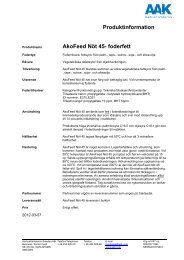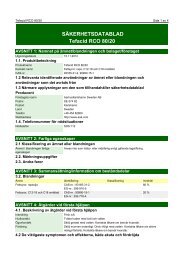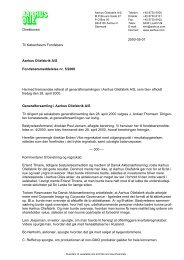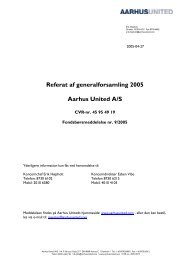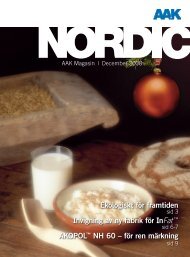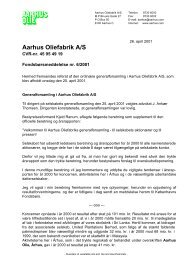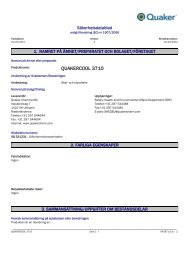Beat Migration Bloom on Chocolate Products by Optimizing ... - AAK
Beat Migration Bloom on Chocolate Products by Optimizing ... - AAK
Beat Migration Bloom on Chocolate Products by Optimizing ... - AAK
You also want an ePaper? Increase the reach of your titles
YUMPU automatically turns print PDFs into web optimized ePapers that Google loves.
<str<strong>on</strong>g>Beat</str<strong>on</strong>g> <str<strong>on</strong>g>Migrati<strong>on</strong></str<strong>on</strong>g> <str<strong>on</strong>g>Bloom</str<strong>on</strong>g> <strong>by</strong> <strong>Optimizing</strong> Your Process<br />
It appears that<br />
the process is the<br />
major part of many<br />
migrati<strong>on</strong> bloom<br />
problems and this<br />
opini<strong>on</strong> is<br />
supported <strong>by</strong><br />
different<br />
investigati<strong>on</strong>s.<br />
A typical well-tempered chocolate c<strong>on</strong>tains ap-<br />
proximately 2 to 4 percent Form V seed crys-<br />
tals when leaving the tempering unit; the Form<br />
V crystals just survive because of their higher<br />
melting point in this specific fat phase.<br />
An excepti<strong>on</strong> is a new technique that seeds<br />
with approximately 0.5 percent Form VI crys-<br />
tals, which ensures Form V crystallizati<strong>on</strong> in the<br />
remaining 99.5 percent cocoa butter and is sta-<br />
ble enough to induce crystallizati<strong>on</strong> at a slightly<br />
higher temperature.<br />
The purpose of all tempering techniques is<br />
basically to start and ensure the Form V crys-<br />
tallizati<strong>on</strong> in a chocolate. If a chocolate is not<br />
seeded correctly with sufficient Form V crystals,<br />
the chocolate will crystallize in a lower form fol-<br />
lowed <strong>by</strong> transformati<strong>on</strong>, resulting in problems<br />
such as poor c<strong>on</strong>tracti<strong>on</strong> and bloom.<br />
Even producing a well-tempered (Form V)<br />
chocolate does not guarantee that the rest of<br />
the chocolate will crystallize in the same poly-<br />
morphic form. The outcome is highly depend-<br />
ent <strong>on</strong> process cooling and heat treatments.<br />
Too fast a cooling will favor Form IV crystalliza-<br />
ti<strong>on</strong> even if the tempering has created perfect<br />
Form V seeds. Too much heat treatment will<br />
melt the seed.<br />
The applicati<strong>on</strong> has a significant influence<br />
up<strong>on</strong> bloom. For applicati<strong>on</strong>s with <strong>on</strong>ly <strong>on</strong>e fat<br />
phase, such as solid bars or solid pralines, it is<br />
not very critical, whereas for applicati<strong>on</strong>s with<br />
more than <strong>on</strong>e fat phase, like filled bars and<br />
pralines, it is much more critical and much<br />
more difficult to understand.<br />
Applicati<strong>on</strong>s c<strong>on</strong>taining more than <strong>on</strong>e fat<br />
phase c<strong>on</strong>stitute perhaps 90 percent of all<br />
bloom problems and for that reas<strong>on</strong> it is the<br />
most important problem to solve.<br />
It appears that the process is the major part<br />
of many migrati<strong>on</strong> bloom problems and this<br />
opini<strong>on</strong> is supported <strong>by</strong> different investigati<strong>on</strong>s.<br />
2 May 2010 • Reprint from The Manufacturing C<strong>on</strong>fecti<strong>on</strong>er<br />
Tri-unsaturated tri-acylglycerols (TAGs) such as<br />
1-oleoyl-2-oleoyl3-oleoyl-glycerol (OOO) accel-<br />
erate the transformati<strong>on</strong> from Form V to Form<br />
VI and it is very likely that the same will happen<br />
with the Form IV to Form V transformati<strong>on</strong>.<br />
The tri-unsaturated TAG, OOO, is the major<br />
TAG in many nuts, e.g., hazelnut, alm<strong>on</strong>d and<br />
peanut, and all are frequently used in many<br />
fillings in large amounts and migrati<strong>on</strong> bloom<br />
is often seen in this kind of applicati<strong>on</strong>. In this<br />
paper, the focus is <strong>on</strong> the tempering test, tem-<br />
pering and the producti<strong>on</strong> cooling, especially<br />
for shell cooling.<br />
TEMPERING<br />
The traditi<strong>on</strong>al way of tempering is a process<br />
where all the chocolate is cooled to a tempera-<br />
ture where the fat phase starts crystallizing in a<br />
mixture of Forms III, IV and V. This process is<br />
based <strong>on</strong> the possibility of remelting all Form<br />
III and Form IV crystals in a following reheating<br />
z<strong>on</strong>e.Then, <strong>by</strong> testing the tempering curve <strong>on</strong><br />
a standard instrument, it should be possible to<br />
determine the tempering c<strong>on</strong>diti<strong>on</strong>s of the final<br />
chocolate.<br />
It is quite easy to evaluate the slope of a tem-<br />
pering curve but not as easy to evaluate the<br />
plateau level or inflecti<strong>on</strong> point of the curve.<br />
It is found that the plateau is correlated to<br />
the crystal stability and bloom stability of the<br />
chocolate.A lower crystallizati<strong>on</strong> plateau pro-<br />
duces less stable crystals and a less bloom-<br />
resistant chocolate. The target for the inflecti<strong>on</strong><br />
plateau must therefore be as high as possible<br />
for a certain chocolate compositi<strong>on</strong>.<br />
It is well known that the fat phase composi-<br />
ti<strong>on</strong> affects the inflecti<strong>on</strong> point level. More milk<br />
fat in a recipe, for example, produces a lower<br />
inflecti<strong>on</strong> point. This fact does not directly influ-<br />
ence the purity of Form V seed crystals because<br />
it is possible to adjust for it. But when tempering






